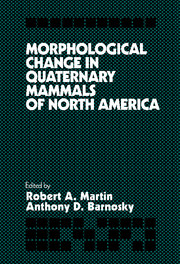Book contents
- Frontmatter
- Contents
- List of Contributors
- Acknowledgments
- 1 Quaternary mammals and evolutionary theory: introductory remarks and historical perspective
- 2 A method for recognizing morphological stasis
- 3 Mosaic evolution at the population level in Microtus pennsylvanicus
- 4 Variogram analysis of paleontological data
- 5 Morphological change in Quaternary mammals: a role for species interactions?
- 6 Rates of evolution in Plio-Pleistocene mammals: six case studies
- 7 Patterns of dental variation and evolution in prairie dogs, genus Cynomys
- 8 Quantitative and qualitative evolution in the giant armadillo Holmesina (Edentata: Pampatheriidae) in Florida
- 9 Evolution of mammoths and moose: the Holarctic perspective
- 10 Evolution of hypsodonty and enamel structure in Plio-Pleistocene rodents
- 11 Patterns of variation and speciation in Quaternary rodents
- 12 Decrease in body size of white-tailed deer (Odocoileus virginianus) during the late Holocene in South Carolina and Georgia
- 13 Short–term fluctuations in small mammals of the late Pleistocene from eastern Washington
- 14 Size change in North American Quaternary jaguars
- 15 Ontogenetic change of Ondatra zibethicus (Arvicolidae, Rodentia) cheek teeth analyzed by digital image processing
- 16 Morphological change in woodrat (Rodentia: Cricetidae) molars
- Index
5 - Morphological change in Quaternary mammals: a role for species interactions?
Published online by Cambridge University Press: 15 December 2009
- Frontmatter
- Contents
- List of Contributors
- Acknowledgments
- 1 Quaternary mammals and evolutionary theory: introductory remarks and historical perspective
- 2 A method for recognizing morphological stasis
- 3 Mosaic evolution at the population level in Microtus pennsylvanicus
- 4 Variogram analysis of paleontological data
- 5 Morphological change in Quaternary mammals: a role for species interactions?
- 6 Rates of evolution in Plio-Pleistocene mammals: six case studies
- 7 Patterns of dental variation and evolution in prairie dogs, genus Cynomys
- 8 Quantitative and qualitative evolution in the giant armadillo Holmesina (Edentata: Pampatheriidae) in Florida
- 9 Evolution of mammoths and moose: the Holarctic perspective
- 10 Evolution of hypsodonty and enamel structure in Plio-Pleistocene rodents
- 11 Patterns of variation and speciation in Quaternary rodents
- 12 Decrease in body size of white-tailed deer (Odocoileus virginianus) during the late Holocene in South Carolina and Georgia
- 13 Short–term fluctuations in small mammals of the late Pleistocene from eastern Washington
- 14 Size change in North American Quaternary jaguars
- 15 Ontogenetic change of Ondatra zibethicus (Arvicolidae, Rodentia) cheek teeth analyzed by digital image processing
- 16 Morphological change in woodrat (Rodentia: Cricetidae) molars
- Index
Summary
Different scientists (e.g., Guthrie, 1984; Martin, 1986) have adduced various evolutionary interpretations of morphological change in different species of Quaternary mammals. “Mere” size fluctuations [to the extent that changes in size can be dissociated from changes in shape (Mosimann and James, 1979)] have often been interpreted as responses to paleoclimatic change in accord with Bergmann's rule, which states that the body sizes of homeotherms from cooler regions tend to exceed the body sizes of those from warmer regions (Bergmann, 1847). This rule was later reformulated by James (1970) to include effects of changes in humidity. Although the physiological interpretation advanced by Bergmann (1847) has been debated (e.g., Scholander, 1955, 1956; Irving, 1957; Hayward, 1965), the notion that morphological clines parallel climatic ones is widely accepted. Climatic fluctuations in the Quaternary have been dramatic, and much research is dedicated to studying them. Consequently, fluctuations in sizes of fossil mammals have often been related to climatic change (Tchernov, 1968; Davis, 1977, 1981; Klein, 1986), although deviations from this relationship, in both time and space, are numerous (Dayan et al., 1991).
The possible evolutionary role of interspecific competition, on the other hand, has been largely neglected in the Quaternary fossil literature. This neglect may reflect the debate over the evolutionary role of interspecific interactions in the neontological literature, where the role of competition in structuring ecological communities and in affecting the morphology of competing animals has been a major source of dispute in evolutionary ecology (Lewin, 1983; Pimm and Gittleman, 1990).
- Type
- Chapter
- Information
- Publisher: Cambridge University PressPrint publication year: 1993
- 2
- Cited by

